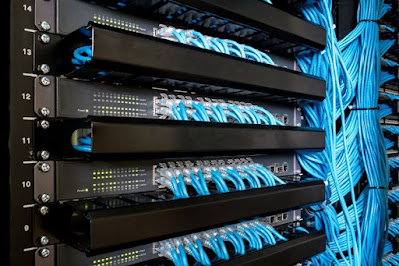9 Advantages of Structured Cabling Installation for Small Businesses
Businesses today increasingly hinge on IT-driven operations,
and an organized cable system is a fundamental necessity in this context.
A Ponemon Institute study in 2017 highlighted that
businesses experience an average loss of $7,900 for each minute of unplanned
downtime. Such downtime can often result from unstructured cabling. By having a
structured cabling
installation system, businesses can significantly enhance their network
functionality.
If you're keen on understanding the benefits that structured
cabling can bring to small businesses, you've come to the right place.
What is structured cabling?
Structured cabling installation constitutes a
comprehensive system of cables, hardware, and ancillary equipment, providing an
extensive telecommunications infrastructure. This infrastructure serves
multiple uses, such as delivering telephone service or transmitting data across
a computer network. As the backbone of any information technology (IT) system,
structured cabling plays a pivotal role in establishing a reliable,
high-performing network.
Structured cabling involves several technical elements:
- Entrance
Facilities: This component signifies where the ISP line enters the
building, housing the demarcation point, main distribution frame, and
equipment rooms.
- Backbone
Cabling: Also referred to as vertical cabling, this incorporates the
transmission lines, connectors, and associated hardware providing
connectivity to the entrance facilities, equipment rooms, and
telecommunications rooms.
- Horizontal
Cabling: This wiring extends from the telecommunications rooms to the
individual outlets or workspaces on the floor, usually via the wire ways,
conduits, or ceiling spaces on each floor.
- Telecommunications
Rooms or Enclosures: This house the terminations of the backbone and
horizontal cables that connect patch panels and switches to other
networked devices.
- Work-Area
Components: This includes patch cables, workstations, telephones, and
other devices.
Why is structured cabling important?
The importance of structured cabling extends to businesses
of all sizes, including small businesses, for multiple reasons. By establishing
an organized, predictable cabling system, structured cable installation
can enhance performance, afford flexibility, and facilitate prompt troubleshooting.
These benefits are critical for the business's operational continuity and
efficiency.
Here is the importance of structured cabling:
- Enhanced
Performance: A well-implemented structured cabling system can deliver
optimal network performance and superior data transfer speeds. In an era
where businesses increasingly rely on data, a high-performing network can
notably enhance productivity and competitiveness.
- Increased
Flexibility: Structured cabling amalgamates all IT network devices and phone
systems, facilitating easy changes and additions. This feature renders
your IT infrastructure adaptable and scalable to your business's growing
needs.
- Simplified
Troubleshooting: A structured cabling system simplifies the identification
and resolution of connectivity issues due to its high organization and
segmentation.
- Future-Proofing:
Structured cabling can accommodate future applications and technological
advancements without requiring an entire system overhaul.
- Reduced
Risk of Downtime: The predictability of a structured cabling system
reduces the risk of human error, thereby minimizing network downtime.
On a technical note, the structured cabling market is
projected to grow at a CAGR of 7.78% from 2022 to 2026 (source: Business Wire,
2021). This projection indicates the escalating importance and relevance of
structured cabling in today's business landscape.
9 Benefits of structured cabling
- Enhances
Efficiency:
Structured cabling system can improve data
transmission speed, boosting overall network performance. According to a report
by CommScope, structured cabling can increase bandwidth by up to 100%.
2.
Eases Management:
A structured cabling system simplifies the network's
management and maintenance, potentially decreasing operational downtime
significantly.
3.
Scales with Your Business:
Structured cabling can adapt to accommodate additional
devices and data loads as your business expands, thus avoiding costly overhauls
and renovations.
4.
Improves Flexibility:
A unified structure supports data, voice, and video
services, enhancing flexibility by eliminating the need for multiple wiring
systems.
5.
Reduces Downtime:
Structured cabling minimizes the risk of human error and
simplifies troubleshooting, thereby reducing downtime.
6.
Cost-Effective:
Over time, the ease of managing a structured cabling solution
can result in significant cost savings in network maintenance and
troubleshooting.
7.
Future-Proof Investment:
Structured cabling can support future technological
advancements, making it a sound long-term investment.
8.
Minimizes Aesthetic Clutter:
A well-organized, neatly arranged cabling system results in
a cleaner, less cluttered aesthetic, improving the work environment.
9.
Boosts Data Processing Capacity:
In conclusion, structured cabling is essential to IT-driven
small businesses. It offers a considerable advantage over older point-to-point
cabling, as it keeps the cables and connections neat. While initial planning
for a cabling structure might be intense, businesses can enjoy peace of mind
knowing they are less likely to face significant downtime due to a
well-structured, organized system.
For small businesses embracing the digital era, structured
cabling provides a robust foundation for growth and efficiency. By improving
network performance, reducing downtime, and offering scalability, structured
cabling not only optimizes current operations but also future-proofs the
business for emerging technological advancements.
For small businesses embracing the digital era, structured
cabling provides a robust foundation for growth and efficiency. By improving
network performance, reducing downtime, and offering scalability, structured
cabling not only optimizes current operations but also future-proofs the
business for emerging technological advancements. For more information, visit
our website: - https://www.cablingindfw.com/data-cabling/



.jpeg)
.png)
Comments
Post a Comment